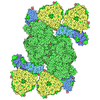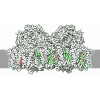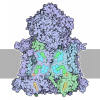+ Open data
Open data
- Basic information
Basic information
| Entry | Database: PDB / ID: 8jzf | |||||||||||||||||||||||||||||||||||||||
|---|---|---|---|---|---|---|---|---|---|---|---|---|---|---|---|---|---|---|---|---|---|---|---|---|---|---|---|---|---|---|---|---|---|---|---|---|---|---|---|---|
| Title | PSI-AcpPCI supercomplex from Symbiodinium | |||||||||||||||||||||||||||||||||||||||
 Components Components |
| |||||||||||||||||||||||||||||||||||||||
 Keywords Keywords | PHOTOSYNTHESIS / Photosysrem I / Dinoflagellate | |||||||||||||||||||||||||||||||||||||||
| Function / homology |  Function and homology information Function and homology information | |||||||||||||||||||||||||||||||||||||||
| Biological species |  Symbiodinium (eukaryote) Symbiodinium (eukaryote) | |||||||||||||||||||||||||||||||||||||||
| Method | ELECTRON MICROSCOPY / single particle reconstruction / cryo EM / Resolution: 2.7 Å | |||||||||||||||||||||||||||||||||||||||
 Authors Authors | Li, X.Y. / Li, Z.H. / Wang, W.D. | |||||||||||||||||||||||||||||||||||||||
| Funding support |  China, 9items China, 9items
| |||||||||||||||||||||||||||||||||||||||
 Citation Citation |  Journal: Proc Natl Acad Sci U S A / Year: 2024 Journal: Proc Natl Acad Sci U S A / Year: 2024Title: Structures and organizations of PSI-AcpPCI supercomplexes from red tidal and coral symbiotic photosynthetic dinoflagellates. Authors: Xiaoyi Li / Zhenhua Li / Fangfang Wang / Songhao Zhao / Caizhe Xu / Zhiyuan Mao / Jialin Duan / Yue Feng / Yang Yang / Lili Shen / Guanglei Wang / Yanyan Yang / Long-Jiang Yu / Min Sang / ...Authors: Xiaoyi Li / Zhenhua Li / Fangfang Wang / Songhao Zhao / Caizhe Xu / Zhiyuan Mao / Jialin Duan / Yue Feng / Yang Yang / Lili Shen / Guanglei Wang / Yanyan Yang / Long-Jiang Yu / Min Sang / Guangye Han / Xuchu Wang / Tingyun Kuang / Jian-Ren Shen / Wenda Wang /   Abstract: Marine photosynthetic dinoflagellates are a group of successful phytoplankton that can form red tides in the ocean and also symbiosis with corals. These features are closely related to the ...Marine photosynthetic dinoflagellates are a group of successful phytoplankton that can form red tides in the ocean and also symbiosis with corals. These features are closely related to the photosynthetic properties of dinoflagellates. We report here three structures of photosystem I (PSI)-chlorophylls (Chls) /-peridinin protein complex (PSI-AcpPCI) from two species of dinoflagellates by single-particle cryoelectron microscopy. The crucial PsaA/B subunits of a red tidal dinoflagellate are remarkably smaller and hence losing over 20 pigment-binding sites, whereas its PsaD/F/I/J/L/M/R subunits are larger and coordinate some additional pigment sites compared to other eukaryotic photosynthetic organisms, which may compensate for the smaller PsaA/B subunits. Similar modifications are observed in a coral symbiotic dinoflagellate species, where two additional core proteins and fewer AcpPCIs are identified in the PSI-AcpPCI supercomplex. The antenna proteins AcpPCIs in dinoflagellates developed some loops and pigment sites as a result to accommodate the changed PSI core, therefore the structures of PSI-AcpPCI supercomplex of dinoflagellates reveal an unusual protein assembly pattern. A huge pigment network comprising Chls and and various carotenoids is revealed from the structural analysis, which provides the basis for our deeper understanding of the energy transfer and dissipation within the PSI-AcpPCI supercomplex, as well as the evolution of photosynthetic organisms. | |||||||||||||||||||||||||||||||||||||||
| History |
|
- Structure visualization
Structure visualization
| Structure viewer | Molecule:  Molmil Molmil Jmol/JSmol Jmol/JSmol |
|---|
- Downloads & links
Downloads & links
- Download
Download
| PDBx/mmCIF format |  8jzf.cif.gz 8jzf.cif.gz | 1.1 MB | Display |  PDBx/mmCIF format PDBx/mmCIF format |
|---|---|---|---|---|
| PDB format |  pdb8jzf.ent.gz pdb8jzf.ent.gz | 1021.1 KB | Display |  PDB format PDB format |
| PDBx/mmJSON format |  8jzf.json.gz 8jzf.json.gz | Tree view |  PDBx/mmJSON format PDBx/mmJSON format | |
| Others |  Other downloads Other downloads |
-Validation report
| Arichive directory |  https://data.pdbj.org/pub/pdb/validation_reports/jz/8jzf https://data.pdbj.org/pub/pdb/validation_reports/jz/8jzf ftp://data.pdbj.org/pub/pdb/validation_reports/jz/8jzf ftp://data.pdbj.org/pub/pdb/validation_reports/jz/8jzf | HTTPS FTP |
|---|
-Related structure data
| Related structure data |  36743MC  8jw0C  8jzeC M: map data used to model this data C: citing same article ( |
|---|---|
| Similar structure data | Similarity search - Function & homology  F&H Search F&H Search |
- Links
Links
- Assembly
Assembly
| Deposited unit | 
|
|---|---|
| 1 |
|
- Components
Components
-Chlorophyll a-chlorophyll c-peridinin-protein-complex I- ... , 12 types, 12 molecules IKGABDFHJLMN
| #1: Protein | Mass: 21839.982 Da / Num. of mol.: 1 / Source method: isolated from a natural source / Source: (natural)  Symbiodinium (eukaryote) Symbiodinium (eukaryote) |
|---|---|
| #2: Protein | Mass: 19596.793 Da / Num. of mol.: 1 / Source method: isolated from a natural source / Source: (natural)  Symbiodinium (eukaryote) Symbiodinium (eukaryote) |
| #5: Protein | Mass: 24560.145 Da / Num. of mol.: 1 / Source method: isolated from a natural source / Source: (natural)  Symbiodinium (eukaryote) Symbiodinium (eukaryote) |
| #6: Protein | Mass: 20093.357 Da / Num. of mol.: 1 / Source method: isolated from a natural source / Source: (natural)  Symbiodinium (eukaryote) Symbiodinium (eukaryote) |
| #18: Protein | Mass: 21264.883 Da / Num. of mol.: 1 / Source method: isolated from a natural source / Source: (natural)  Symbiodinium (eukaryote) Symbiodinium (eukaryote) |
| #19: Protein | Mass: 17493.844 Da / Num. of mol.: 1 / Source method: isolated from a natural source / Source: (natural)  Symbiodinium (eukaryote) Symbiodinium (eukaryote) |
| #20: Protein | Mass: 19335.070 Da / Num. of mol.: 1 / Source method: isolated from a natural source / Source: (natural)  Symbiodinium (eukaryote) Symbiodinium (eukaryote) |
| #21: Protein | Mass: 17109.432 Da / Num. of mol.: 1 / Source method: isolated from a natural source / Source: (natural)  Symbiodinium (eukaryote) Symbiodinium (eukaryote) |
| #22: Protein | Mass: 22912.516 Da / Num. of mol.: 1 / Source method: isolated from a natural source / Source: (natural)  Symbiodinium (eukaryote) Symbiodinium (eukaryote) |
| #23: Protein | Mass: 20585.494 Da / Num. of mol.: 1 / Source method: isolated from a natural source / Source: (natural)  Symbiodinium (eukaryote) Symbiodinium (eukaryote) |
| #24: Protein | Mass: 19381.953 Da / Num. of mol.: 1 / Source method: isolated from a natural source / Source: (natural)  Symbiodinium (eukaryote) Symbiodinium (eukaryote) |
| #25: Protein | Mass: 17119.342 Da / Num. of mol.: 1 / Source method: isolated from a natural source / Source: (natural)  Symbiodinium (eukaryote) Symbiodinium (eukaryote) |
-Photosystem I ... , 13 types, 13 molecules zycdefhijlmab
| #3: Protein | Mass: 6656.196 Da / Num. of mol.: 1 / Source method: isolated from a natural source / Source: (natural)  Symbiodinium (eukaryote) Symbiodinium (eukaryote) |
|---|---|
| #4: Protein | Mass: 11166.757 Da / Num. of mol.: 1 / Source method: isolated from a natural source / Source: (natural)  Symbiodinium (eukaryote) Symbiodinium (eukaryote) |
| #7: Protein | Mass: 9425.731 Da / Num. of mol.: 1 / Source method: isolated from a natural source / Source: (natural)  Symbiodinium (eukaryote) Symbiodinium (eukaryote) |
| #8: Protein | Mass: 24878.785 Da / Num. of mol.: 1 / Source method: isolated from a natural source / Source: (natural)  Symbiodinium (eukaryote) Symbiodinium (eukaryote) |
| #9: Protein | Mass: 8266.334 Da / Num. of mol.: 1 / Source method: isolated from a natural source / Source: (natural)  Symbiodinium (eukaryote) Symbiodinium (eukaryote) |
| #10: Protein | Mass: 20609.658 Da / Num. of mol.: 1 / Source method: isolated from a natural source / Source: (natural)  Symbiodinium (eukaryote) Symbiodinium (eukaryote) |
| #11: Protein | Mass: 15221.271 Da / Num. of mol.: 1 / Source method: isolated from a natural source / Source: (natural)  Symbiodinium (eukaryote) / References: UniProt: A0A812Q823 Symbiodinium (eukaryote) / References: UniProt: A0A812Q823 |
| #12: Protein | Mass: 13699.559 Da / Num. of mol.: 1 / Source method: isolated from a natural source / Source: (natural)  Symbiodinium (eukaryote) / References: UniProt: A0A812IJ75 Symbiodinium (eukaryote) / References: UniProt: A0A812IJ75 |
| #13: Protein | Mass: 11153.527 Da / Num. of mol.: 1 / Source method: isolated from a natural source / Source: (natural)  Symbiodinium (eukaryote) / References: UniProt: A0A812LLR4 Symbiodinium (eukaryote) / References: UniProt: A0A812LLR4 |
| #14: Protein | Mass: 27708.895 Da / Num. of mol.: 1 / Source method: isolated from a natural source / Source: (natural)  Symbiodinium (eukaryote) Symbiodinium (eukaryote) |
| #15: Protein | Mass: 8527.976 Da / Num. of mol.: 1 / Source method: isolated from a natural source / Source: (natural)  Symbiodinium (eukaryote) / References: UniProt: A0A812M556 Symbiodinium (eukaryote) / References: UniProt: A0A812M556 |
| #16: Protein | Mass: 75785.336 Da / Num. of mol.: 1 / Source method: isolated from a natural source / Source: (natural)  Symbiodinium (eukaryote) Symbiodinium (eukaryote) |
| #17: Protein | Mass: 74438.906 Da / Num. of mol.: 1 / Source method: isolated from a natural source / Source: (natural)  Symbiodinium (eukaryote) Symbiodinium (eukaryote) |
-Sugars , 1 types, 7 molecules 
| #30: Sugar | ChemComp-DGD / |
|---|
-Non-polymers , 11 types, 303 molecules 


















| #26: Chemical | ChemComp-DD6 / ( #27: Chemical | ChemComp-UIX / [( Mass: 642.907 Da / Num. of mol.: 7 / Source method: obtained synthetically / Formula: C42H58O5 / Feature type: SUBJECT OF INVESTIGATION #28: Chemical | ChemComp-CLA / #29: Chemical | ChemComp-KC1 / #31: Chemical | ChemComp-LMG / #32: Chemical | ChemComp-PID / #33: Chemical | ChemComp-SQD / | #34: Chemical | #35: Chemical | ChemComp-BCR / #36: Chemical | #37: Chemical | ChemComp-LHG / | |
|---|
-Details
| Has ligand of interest | Y |
|---|---|
| Has protein modification | Y |
-Experimental details
-Experiment
| Experiment | Method: ELECTRON MICROSCOPY |
|---|---|
| EM experiment | Aggregation state: PARTICLE / 3D reconstruction method: single particle reconstruction |
- Sample preparation
Sample preparation
| Component | Name: PSI-AcpPCI supercomplex from Symbiodinium / Type: COMPLEX / Entity ID: #1-#25 / Source: NATURAL |
|---|---|
| Source (natural) | Organism:  Symbiodinium (eukaryote) Symbiodinium (eukaryote) |
| Buffer solution | pH: 7.5 |
| Specimen | Embedding applied: NO / Shadowing applied: NO / Staining applied: NO / Vitrification applied: YES |
| Vitrification | Cryogen name: ETHANE |
- Electron microscopy imaging
Electron microscopy imaging
| Experimental equipment |  Model: Titan Krios / Image courtesy: FEI Company |
|---|---|
| Microscopy | Model: FEI TITAN KRIOS |
| Electron gun | Electron source:  FIELD EMISSION GUN / Accelerating voltage: 300 kV / Illumination mode: FLOOD BEAM FIELD EMISSION GUN / Accelerating voltage: 300 kV / Illumination mode: FLOOD BEAM |
| Electron lens | Mode: BRIGHT FIELD / Nominal defocus max: 2000 nm / Nominal defocus min: 1000 nm |
| Image recording | Electron dose: 60 e/Å2 / Film or detector model: GATAN K3 BIOQUANTUM (6k x 4k) |
- Processing
Processing
| EM software | Name: PHENIX / Category: model refinement | ||||||||||||||||||||||||
|---|---|---|---|---|---|---|---|---|---|---|---|---|---|---|---|---|---|---|---|---|---|---|---|---|---|
| CTF correction | Type: PHASE FLIPPING AND AMPLITUDE CORRECTION | ||||||||||||||||||||||||
| 3D reconstruction | Resolution: 2.7 Å / Resolution method: FSC 0.143 CUT-OFF / Num. of particles: 216895 / Symmetry type: POINT | ||||||||||||||||||||||||
| Refine LS restraints |
|
 Movie
Movie Controller
Controller





 PDBj
PDBj















